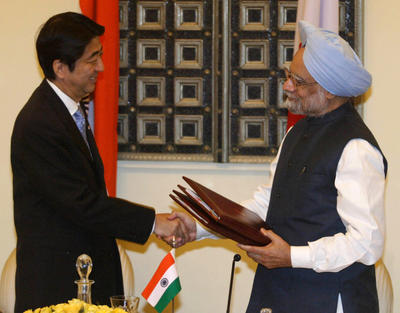The most important development is the announcement that Emperor Akihito and Empress Michiko will make an official visit to India starting on 30 November. India has long been eager to invite the imperial dignitaries, and the May 2013 joint statement made specific reference to this. The emperor’s itinerary is being planned with meticulous care, and the Indian government has appointed a senior Congress party leader to coordinate the royal visit. But Emperor Akihito is no stranger to India, having first visited in December 1960 — soon after his marriage to Michiko and before he ascended the throne in 1989. Former Indian prime minister Jawaharlal Nehru, president Rajendra Prasad and vice president Radhakrishnan also paid separate goodwill visits to Japan between 1956 and 1958, which, in a way, helped Japan in its strenuous quest to establish its Asian identity.
Both countries consider the imperial visit to be a landmark event capable of giving further impetus to the growing partnership. The fact that the Japanese imperial dignitaries now rarely make international trips due to their health further heightens the significance of their sojourn. Moreover, the coming visit is highly symbolic of potential future defence and civil nuclear cooperation.
Defence cooperation is one particular area in which the two countries wish to develop new and mutually beneficial interactions. In their May joint statement, the two leaders expressed their satisfaction at expanding defence relations in areas such as joint naval exercises, and also expressed a desire to increase the frequency of their cooperation. They agreed to explore the prospect of Japan selling its indigenously-made US-2 amphibious aircraft to India. And they decided to create a joint working group to examine the modalities of cooperation on the issue.
Given Japan’s extreme sensitivity to arms sales to foreign countries, its decision to sell aircraft to India came as a big surprise to everyone. If the deal goes through successfully, it will be the first time Japan exports defence hardware to a major Asian country. A Japanese defence delegation visited India in the second week of July to see whether defence cooperation might also be taken to the next level through technology and equipment transfers between the two countries. Though Japan decided in 1967 to ban the export of military technologies to foreign countries, it modified its position in 2011 and has gradually relaxed its export policy. Many in India seem to prefer joint defence production with Japan instead of importing Japanese finished products, while Japan has been steadily removing many Indian companies from its export control list.
The second India-Japan naval exercise, scheduled to be held before the end of the year, is expected to be much bigger than the first one held in June 2012. The first bilateral maritime affairs dialogue was held in New Delhi on 29 July 2013. As Tokyo attaches great importance to security cooperation with India it has decided to add two more attaches to its embassy in New Delhi. With Abe scheduled to make his visit to India for the next annual summit soon after the Emperor’s visit, the prospect of a major breakthrough in bilateral defence cooperation is quite bright.
In addition, India and Japan have resumed civilian nuclear cooperation negotiations. Though they had already conducted three rounds of talks, the 2011 Fukushima tragedy became a formidable barrier to any further bilateral dialogue. But the prospect of an accord brightened after Abe’s return to power, and the fourth round of negotiations was resumed on 3 September in an atmosphere marked by cautious optimism. Unfortunately, the two countries could not achieve a breakthrough and stood steadfastly by their well-stated positions on the issue. Right now, the atmosphere for further dialogue is not ideal, due to reports of massive leaks of radioactive water at the Fukushima Daiichi nuclear plant, vigorous anti-nuclear protests by several private groups and the decision to terminate operations at all 50 nuclear reactors across the country.
But with Abe seriously committed to pursuing the civilian nuclear option, and with influential business interests supporting him, it is very likely an agreement will be reached. On 17 September, Prime Minister Abe assured Ashwani Kumar, the visiting special envoy of Manmohan Singh, that he would vigorously pursue negotiations for an agreement on civilian nuclear cooperation.
Finally, considering the current steep depreciation of the Indian rupee, both countries decided to expand their prevailing currency swap arrangements. India and Japan started the currency swap deal in 2008 with the relatively small amount of US$3 billion. When it expired in 2012, a new swap arrangement for US$15 billion was signed. This amount has now been increased to US$50 billion. A joint press statement issued on 6 September 2013 pointed out that it was necessary to pursue reforms in the financial and investment sectors to strengthen bilateral financial cooperation between the two countries.
Such currency swap arrangements have become quite common among many Asian countries and give the countries concerned a cushion to manage their current account deficits. While India may not actually use these dollars, the deal provides a psychological feeling of comfort for both India and Japanese investors.
K.V. Kesavan is a distinguished fellow at the Observer Research Foundation, New Delhi.


Emperor Akihito, then Crown Prince, had visited India with Princess Michiko and his Fuji Guruji and the entourage in 1982, covering Rajgir, Griddhakoot (with Japanese donated ropeway to the hill), Bodh Gaya and then to Kushinagar, where the Japanese style meditation-cum-tourist rest house foundation was laid.Union Tourism minister AP Sharma and I had accompanied the group. The great regard for India and holy places of Buddhist piligrimage shown by him, the princess and the whole group charmed everyone. The Tourism Ministry Secretary Mr Venkataraman remarked on how the mantras recited by the Guruji at the ceremony were varations from sanskrit.
Mr Kunwar, thank you so much for that piece of information regarding the emperor’s visit in 1982. It would be a great help if you could throw some light on the month in 1982 when the emperor came to India.